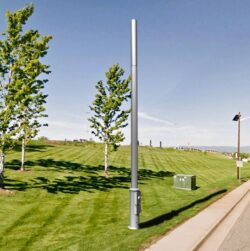Small Cell Wireless

Small Cell Wireless Facility
Given our increasing daily use of wireless communication and a recent law passed by the Colorado Legislature, the City of Lone Tree and neighboring municipalities must allow the installation of small cell wireless facilities in the area.
A small cell wireless facility is part of a larger network that provides cellular service to smartphones, tablets and other cellular devices. The facilities are called “small cell” because they provide low-powered signals to complement a larger cellular network. They have a shorter range and use smaller equipment than larger cellular towers.
Current Installation Locations
Here are the most recent locations where small cell wireless facilities could be installed in Lone Tree. These installations are for standard or LTE service but have the capability to provide 5G technology in the future.
- 8402 Lincoln
- 10053 Carriage Club Drive
- 9662 E Lincoln
- 7920 E Lincoln
- 10430 Rivington Ct
- 9261 RidgeGate Pkwy
- 9893 RidgeGate Pkwy
- 10149 RidgeGate Pkwy
- 10320 RidgeGate Pkwy
- 10197 RidgeGate Cir
- 9493 Ptarmigan Trail
- 9701 Ptarmigan Trail
- 10049 Crooked Stick Trail
- 10368 Park Meadows Blvd
- 9929 Park Meadows Blvd
- 9555 Halstead Ln
- 7720 Timberline Road
- 11586 E Lincoln Ave
- 9498 Crossington Way
- 10200 Bluffmont Dr
- 10307 Bluffmont Dr
- 10821 S Havana St
- 8333 Chester St
- 7810 Sweet Water Rd
- 9704 Sky Ridge Ave
- 9203 Sky Ridge Ave
- 9934 Trainstation Cir
- 10368 Hillston St
- 10446 Montecito Dr
- 10675 Alicante Rd
Q: WHAT IS A SMALL CELL WIRELESS FACILITY?
A: A small cell wireless facility is part of a larger network that provides cellular service to smartphones, tablets and other cellular devices. The facilities are called “small cell” because they provide low-powered signals to complement a larger cellular network. They have a shorter range and use smaller equipment than larger cellular towers.
Q: WHAT ARE THE BENEFITS OF SMALL CELL FACILITIES IN OUR COMMUNITY?
A: Small cell facilities are critical to faster and more consistent connectivity. The demand for cellular service is increasing exponentially as people become more dependent upon high-quality cellular service for personal, business and public safety communications, as well as for entertainment.
Q: WHERE CAN SERVICE PROVIDERS INSTALL THESE FACILITIES?
A: In 2017, the Colorado state legislature passed a law requiring cities to allow construction of small cell facilities in the City’s right of way (ROW). The ROW is a City-owned strip of land that includes the street, sidewalk and oftentimes a few feet beyond the sidewalk.
Q: CAN THE CITY PROHIBIT SMALL CELL FACILITIES IN CITY-OWNED RIGHT OF WAY?
A: No. The 2017 state law requires the City to accommodate these facilities in the ROW.
Q: CAN THE CITY DETERMINE THE NUMBER, SIZE OR DESIGN OF THESE FACILITIES?
A: Under current state and federal law, the City has limited ability to regulate these facilities. For example, the City of Lone Tree’s ordinance limits the distance (600 feet) between new facilities, the height (30 feet ) and the color.
Q: WHAT WILL THEY LOOK LIKE?
A: The City is working with providers to install free-standing poles with a limited profile or poles designed to be integrated with street lights. To date, all proposals have been for 30-foot free-standing poles. The poles are either black or green, depending on the colors of street light or traffic signal poles in the immediate neighborhood.
Q: CAN THE CITY CONSIDER THE EFFECT ON PROPERTY VALUES?
A: No. Because of state and federal regulations, the City cannot consider the effect a new wireless installation may have on adjacent property values.
Q: CAN THE CITY SUSPEND OR TEMPORARILY SUSPEND THE INSTALLATION OF SMALL CELL FACILITIES?
A: No. The FCC ruled (FCC-18-111) that local jurisdictions do not have the legal authority to suspend small cell facility installation.
Q: CAN THE CITY DIRECT THE EXACT LOCATION OF THESE FACILITIES BASED ON HEALTH CONCERNS?
A: No, The Telecommunications Act of 1996 contained provisions relating to federal jurisdiction to regulate human exposure to RF emissions from certain transmitting devices. In particular, Section 704 of the Act states that, “No State or local government or instrumentality thereof may regulate the placement, construction, and modification of personal wireless service facilities on the basis of the environmental effects of radio frequency emissions to the extent that such facilities comply with the Commission’s regulations concerning such emissions.”
Q: ARE SMALL CELL WIRELESS FACILITIES SAFE?
A: The FCC is responsible for regulating small cell facilities and establishing the safety guidelines for radiofrequency emissions levels. The FCC states that radiofrequency emissions from antennas used for cellular and PCS transmissions result in exposure levels on the ground that are typically thousands of times below safety limits. These safety limits were adopted by the FCC based on the recommendations of expert organizations and endorsed by agencies of the Federal Government responsible for health and safety. Therefore, there is no reason to believe that such towers could constitute a potential health hazard. For more information on RF safety, visit the FCC RF Safety FAQs.
